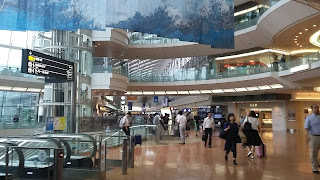 Lunch consisted of a small appetizer (pictured), salad, soup, a main course (fish, shrimp, vegetables, bacon-wrapped something), and dessert (fruit and a small piece of cheesecake) – all for 2000 yen! Portions were small, but it was delicious. Before the meal, I and a couple other newer members introduced themselves. I gave a longer jikoshoukai (self introduction) than I was used to – I said my name, my job/school, where I come from, and what my studies were in college. While people were eating, members would play various fun pieces in chamber-sized groups. At the request of the other members, I played first (Bach solo cello suite no.1, prelude) and sight-read many things with the others (I Dreamed a Dream from Les Miserables, Habanera from Carmen, the Mission Impossible theme, the Jurassic Park theme, some traditional island songs, the Addams family theme, a Mozart horn quintet, a Joe Hisaishi piece, etc.). The violins played a selection from Pirates of the Caribbean, and a viola duet played karaoke "Let it Go."
Lunch consisted of a small appetizer (pictured), salad, soup, a main course (fish, shrimp, vegetables, bacon-wrapped something), and dessert (fruit and a small piece of cheesecake) – all for 2000 yen! Portions were small, but it was delicious. Before the meal, I and a couple other newer members introduced themselves. I gave a longer jikoshoukai (self introduction) than I was used to – I said my name, my job/school, where I come from, and what my studies were in college. While people were eating, members would play various fun pieces in chamber-sized groups. At the request of the other members, I played first (Bach solo cello suite no.1, prelude) and sight-read many things with the others (I Dreamed a Dream from Les Miserables, Habanera from Carmen, the Mission Impossible theme, the Jurassic Park theme, some traditional island songs, the Addams family theme, a Mozart horn quintet, a Joe Hisaishi piece, etc.). The violins played a selection from Pirates of the Caribbean, and a viola duet played karaoke "Let it Go."Before leaving the city, FJ-san showed me the orchestra’s usual rehearsal spaces in Naze, On the drive back, we stopped to see a mangrove forest (pictured). Mangroves are plants that grow in brackish water (a mix of freshwater and seawater). A nearby establishment offers tour-it-yourself canoe rentals that you can use to admire the greenery up close.
When we arrived back in Koniya, FJ-san invited me to his house, where I met his wife (piano teacher and amateur soprano) and the local eikaiwa (English conversation school) teacher who stopped by to say hello. They showed me a DVD of Amami Orchestra from 2014 performing the fourth movement of Beethoven’s ninth, under the baton of a conductor from Tokyo. (I was told that the given the amateur level of Amami orchestra, they had some backup from more experienced players from the Kagoshima mainland.)
Before long one of Koniya HS's students showed up for his piano lesson, but it sort of turned into an impromptu cello lesson instead. One of the nice things about arriving during summer vacation is the chance to meet a few students outside of the classroom, which makes eventual interactions inside the classroom a tad less awkward.
Anyway, even though the overall level of the Amami orchestra is not very high, I'm going to have fun making music with them as they attempt to tackle the third and fourth movements of the beast that is Beethoven's ninth.






















